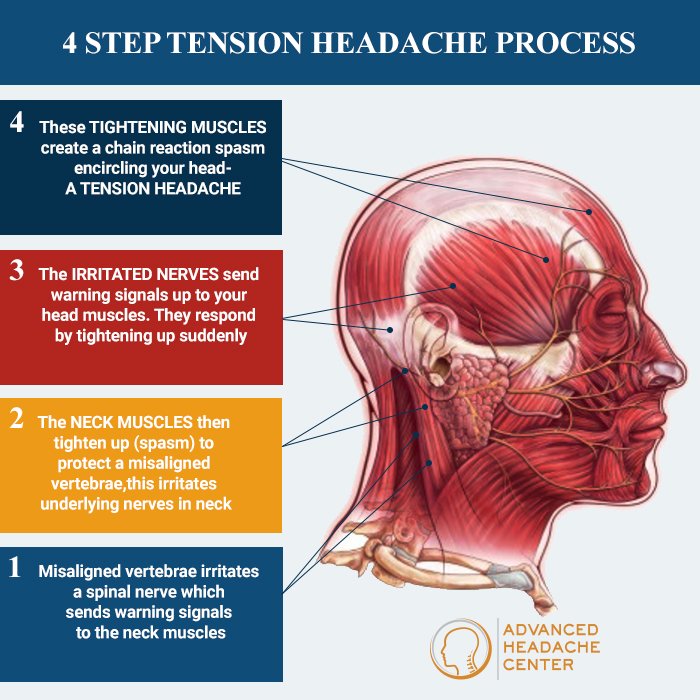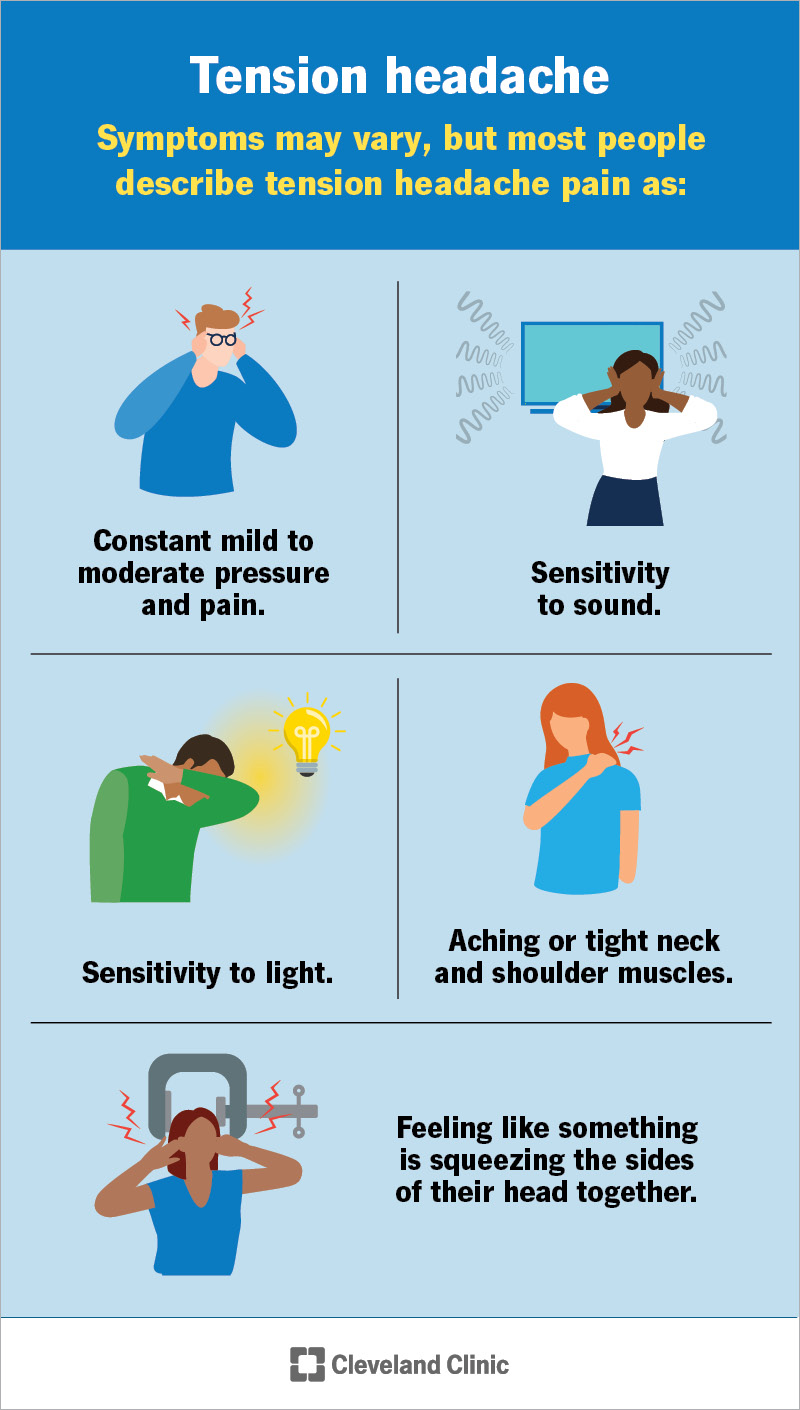Tension headaches are common and can disrupt your daily life. They often feel like a band squeezing around your head.
Imagine feeling a tightness around your head. This is what a tension headache feels like. It’s the most common type of headache and affects many people. Stress, poor posture, and muscle tension are usual causes. These headaches can be mild or intense.
They can last from minutes to days. Understanding tension headaches helps you manage them better. Knowing what triggers them can reduce their frequency. In this blog post, we will explore what tension headaches are, their causes, and how to find relief. By the end, you’ll have useful tips to ease the pain and improve your quality of life.

Credit: www.advancedheadachecenter.com
Causes Of Tension Headaches
Tension headaches are a common type of headache. They often feel like a tight band around the head. Understanding the causes can help in managing these headaches. Various factors can trigger a tension headache.
Common Triggers
Many things can trigger tension headaches. Stress is a major factor. Work, school, and personal issues can cause stress. Poor posture can also lead to tension headaches. Sitting or standing in one position for too long can strain the muscles. Eye strain from computer screens or reading can be a trigger. Skipping meals or dehydration can also cause tension headaches.
Lifestyle Factors
Lifestyle choices play a big role in tension headaches. Lack of sleep is a common cause. Aim for at least seven to eight hours of sleep each night. Poor diet can also contribute. A balanced diet helps maintain energy levels and reduces headaches. Regular exercise can prevent tension headaches. Staying active keeps muscles relaxed and reduces stress. Avoiding excessive caffeine and alcohol can also help. These substances can lead to dehydration and trigger headaches.

Credit: ufhealth.org
Symptoms To Watch For
Tension headaches are common. They can be uncomfortable and disruptive. Recognizing the symptoms early can help manage them better. Understanding both physical and mental indicators is crucial. Let's explore the symptoms you should watch for.
Physical Signs
The first sign of a tension headache is a dull pain. This pain often starts in the head. It can spread to the neck and shoulders. You may also feel tightness around the forehead. This tightness can feel like a band squeezing your head. Another sign is tenderness on your scalp. Light pressure can trigger discomfort. Sometimes, you might experience pressure behind the eyes. This can add to the overall discomfort.
Mental Indicators
Tension headaches also affect your mental state. You might feel increased irritability. Small things can upset you more than usual. Concentration can become difficult. Tasks that need focus seem harder. You may also experience disrupted sleep. Worry and anxiety can increase. This mental strain often makes the headache worse.
Immediate Pain Relief
Immediate pain relief is crucial for those suffering from tension headaches. They can disrupt daily activities and lower productivity. Quick solutions can help manage the pain and get you back on track. Here are some effective options for immediate relief.
Over-the-counter Medications
Over-the-counter (OTC) medications can provide fast relief from tension headaches. Common options include ibuprofen, acetaminophen, and aspirin. These drugs help reduce inflammation and ease pain. Follow the dosage instructions on the packaging. Avoid taking more than recommended.
Some medications combine pain relievers with caffeine. Caffeine enhances the effectiveness of the pain reliever. Do not overuse OTC medications. Frequent use can lead to rebound headaches.
Home Remedies
Home remedies offer a natural way to ease tension headaches. A cold or warm compress can provide immediate relief. Apply the compress to your forehead or neck. The cold compress reduces inflammation. The warm compress relaxes tight muscles.
Hydration is also important. Drink plenty of water to stay hydrated. Dehydration can cause or worsen headaches. Rest in a dark, quiet room. Minimizing sensory input can help reduce headache pain.
Essential oils like peppermint or lavender can also be helpful. Dilute the oil and apply it to your temples. The soothing aroma can ease tension and pain.
Stress Management Techniques
Stress is a common trigger for tension headaches. Learning to manage stress can help reduce their frequency and intensity. Here, we explore effective stress management techniques to help you find relief.
Relaxation Exercises
Relaxation exercises can ease muscle tension and calm your mind. Deep breathing is a simple technique. Sit comfortably, close your eyes, and inhale slowly. Hold your breath for a few seconds, then exhale slowly. Repeat this process several times.
Progressive muscle relaxation is another effective exercise. Focus on one muscle group at a time. Tense the muscles for a few seconds, then relax them. Start from your toes and work your way up to your head.
Mindfulness Practices
Mindfulness practices can reduce stress and improve mental clarity. Try mindfulness meditation. Sit quietly, close your eyes, and focus on your breathing. If your mind wanders, gently bring your focus back to your breath.
Another practice is mindful walking. Pay attention to the sensation of your feet touching the ground. Notice the sights and sounds around you. Stay present in the moment.
Ergonomic Adjustments
Tension headaches are often linked to poor ergonomics. Making ergonomic adjustments can reduce headache frequency and intensity. Small changes in your workspace and posture can make a big difference.
Workstation Setup
Start with your chair. It should support your lower back. Adjust the height so your feet rest flat on the floor. Your knees should be at a right angle. Use a footrest if needed.
Next, check your desk. It should be at elbow height. Your forearms should rest parallel to the floor. Keep your keyboard and mouse within easy reach. This prevents you from stretching too far.
Your monitor should be at eye level. The top of the screen should be at or just below eye level. This keeps your neck in a neutral position. Place the monitor about an arm's length away. Adjust the brightness and contrast to reduce eye strain.
Posture Tips
Good posture is key to preventing tension headaches. Sit up straight with your shoulders relaxed. Avoid slouching or leaning forward. Keep your head aligned with your spine.
Take breaks to move around. Sitting for long periods can strain your muscles. Stand up and stretch every 30 minutes. This helps reduce tension in your neck and shoulders.
Use a lumbar roll or cushion for extra support. This helps maintain the natural curve of your spine. Practice deep breathing exercises. This can also help relax your muscles and reduce stress.
Hydration And Nutrition
Hydration and Nutrition play a vital role in managing tension headaches. Keeping your body well-hydrated and eating a balanced diet can help prevent these headaches. Below, we discuss the importance of water intake and making the right dietary choices.
Water Intake
Dehydration is a common cause of tension headaches. Drinking enough water is essential for overall health and well-being. Aim to drink at least eight glasses of water a day.
Signs of dehydration include:
- Dry mouth
- Fatigue
- Dark urine
Make it a habit to carry a water bottle with you. Sipping water throughout the day keeps you hydrated. This simple habit can significantly reduce the frequency of tension headaches.
Dietary Choices
Your diet has a direct impact on your headache frequency. Certain foods can trigger tension headaches, while others can help prevent them.
Avoid:
- Caffeine
- Alcohol
- Processed foods
Include:
- Fruits
- Vegetables
- Whole grains
Eating regular meals can also help. Skipping meals can lead to low blood sugar, which might trigger a headache. Try to eat balanced meals at regular intervals.
| Food Type | Examples |
|---|---|
| Fruits | Apples, Bananas, Berries |
| Vegetables | Spinach, Carrots, Broccoli |
| Whole Grains | Oats, Brown Rice, Quinoa |
A healthy diet combined with adequate hydration can help manage tension headaches effectively. Making mindful choices in your daily routine can lead to significant improvements.
Regular Physical Activity
Regular physical activity can help reduce tension headaches. Exercise helps release endorphins, the body's natural painkillers. It also promotes better circulation and reduces muscle tension. These benefits can prevent or alleviate tension headaches.
Exercise Routines
Engaging in regular exercise routines can make a big difference. Aim for at least 30 minutes of moderate exercise daily. Activities like walking, swimming, or cycling are great choices. These activities increase heart rate and improve blood flow. This helps reduce the frequency and intensity of headaches.
Consistency is key. Create a schedule and stick to it. Listen to your body and don't overdo it. The goal is to stay active without causing strain.
Stretching Exercises
Stretching exercises can ease muscle tension. Focus on stretching the neck, shoulders, and upper back. These areas often hold the most tension. Simple stretches like neck rolls, shoulder shrugs, and upper back stretches are effective. Perform these stretches several times a day.
Stretching can be done anywhere, at any time. It’s an easy way to relieve tension. Hold each stretch for at least 15 seconds. Breathe deeply and relax into the stretch. This can help prevent headaches and improve overall flexibility.

Credit: my.clevelandclinic.org
When To Seek Medical Help
Tension headaches are common and usually not serious. Yet, there are times when you should see a doctor. Understanding when to seek medical help is important.
Persistent Pain
If you have a headache that lasts for days or weeks, see a doctor. Persistent pain can be a sign of something more serious. Chronic headaches need medical attention.
Take note if your headache does not go away with usual treatments. Over-the-counter pain relievers should help. If they don't, consult your healthcare provider.
Other Warning Signs
Watch for other symptoms that come with your headache. These can indicate a more serious condition. Seek help if you have:
- Sudden, severe headache
- Confusion or trouble understanding speech
- Vision changes
- Weakness or numbness
- Fever or stiff neck
These symptoms need immediate medical attention. They can be signs of an underlying issue like an infection or stroke.
If you experience any of these warning signs, do not wait. Contact a healthcare professional right away.
Frequently Asked Questions
What Causes Tension Headaches?
Tension headaches are often caused by stress, muscle tension, or anxiety. Poor posture and fatigue can also contribute. Identifying triggers can help manage them.
How Can You Treat Tension Headaches?
Tension headaches can be treated with over-the-counter pain relievers. Relaxation techniques like deep breathing and meditation also help. Regular exercise can prevent them.
Are Tension Headaches Common?
Yes, tension headaches are very common. They are the most common type of headache. Many people experience them occasionally.
Can Dehydration Cause Tension Headaches?
Yes, dehydration can lead to tension headaches. It's important to stay hydrated. Drink plenty of water throughout the day.
Conclusion
Relieving tension headaches is possible with simple lifestyle changes. Stay hydrated. Maintain good posture. Practice relaxation techniques. Regular exercise also helps reduce stress. Over-the-counter pain relievers can provide relief. Consult a doctor for persistent headaches. Making these small changes can lead to fewer headaches.
Prioritize self-care and healthy habits. Your well-being matters. Remember, consistent efforts can lead to significant improvements. Keep these tips in mind. Enjoy a headache-free life.






